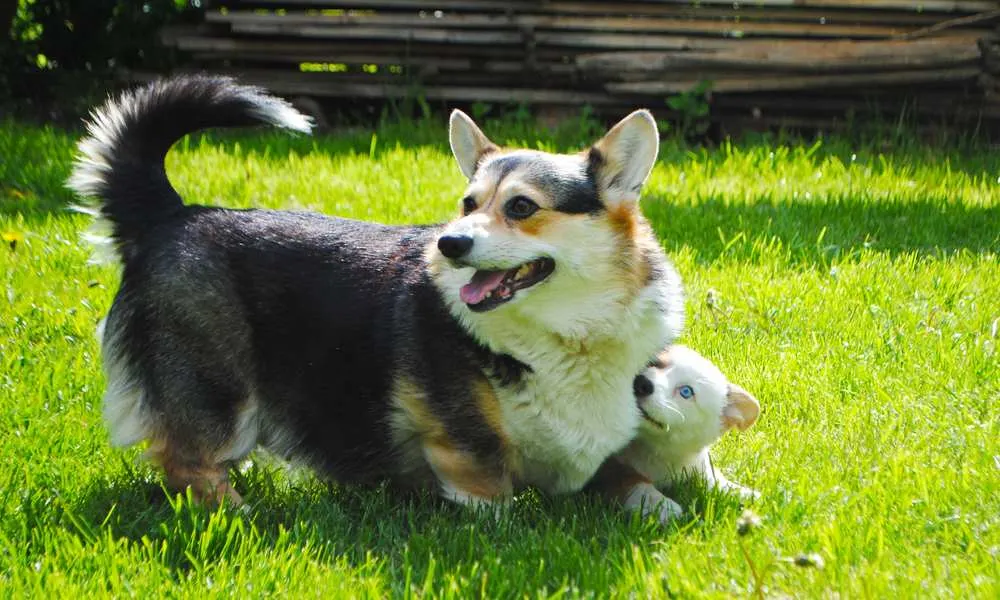Is there anything cuter than a corgi wagging his little butt, thinking it’s his tail? It’s beyond cute.
What is not so cute is that what now looks like a stump should have been a tail because most corgis have their tail docked. Let that settle in.
We’ll go a lot more in-depth about this ”tradition” and the reasoning behind it, but, just so we’re clear, we do not support cutting off corgis’ tails or any breed’s tail for that matter.
This article will contain many instances where we’ll mention that something is being cut off, and if you’re not into that sort of thing, it’s completely fine if you read just the conclusion.
Now that that’s out of the way, get ready to find out everything about corgi tails.

Are Corgis Born With Tails?
There are two breeds of corgis; those that get to keep their tails and those that have them docked.
The Pembroke Welsh corgi which has a bobbed or docked tail is the representative of the latter type. Pembrokes can be born without a tail, although they require special breeding.
Thinking about the former type, the Cardigan Welsh corgi comes to mind; they don’t have a docked tail.
We’ll talk about this a lot more in depth later in the article.

What Is Docking?
Docking is cutting off a part of a dog’s tail, or even sometimes an entire tail. It’s done without any anesthetic drugs and when a dog is still only a few days old.
Docking tails is a practice thousands of years old. It began in Ancient Rome, and it’s still popular even today.
Romans thought that by cutting off a dog’s tail, they would prevent rabies.
Then, a theory that by cutting off a dog’s tail, you’ll be preventing possible injuries also appeared.
Dogs that are used for hunting often go into dense forest areas and thickets, which means they might ‘pick up’ something on their tail that could cause an infection or an injury.
Needless to say, hunting dogs got their tail wagging rights revoked following that theory.
In general, ‘work’ dogs have their tails docked precisely because it might cause an injury or an infection, even though veterinary associations throughout the world don’t support docking.

Do Corgis Naturally Have Tails?
Yes, corgis naturally have tails. However, there are cases where corgis have intentionally been bred not to have a tail. This is only the case with the Pembroke Welsh Corgis, though.
Why Do Corgis Tails Get Docked / Cut Off?

1. Esthetics
We’ll go over the other reasons as well, but the primary reason why Pembroke Welsh Corgis get their tails docked is the way it looks.
The AKC (American Kennel Club) won’t allow a Pembroke Welsh Corgi to be registered with their organization unless you perform the docking procedure.
This is what their Official Standard says: “Tail – Docked as short as possible without being indented.“
Supposedly, this is to prevent injuries that could be sustained during herding duties.
The only reason one would register one’s Pembroke with the AKC would be to present in dog shows and not use it as a herding dog.
It’s borderline barbaric that the AKC insists on cutting parts of a dog because that’s how it’s “supposed” to be.

2. Tradition
As we said, docking tails isn’t anything new.
But what about corgi tails? Has it always been that way, are all corgis sentenced to tail castration as soon as they’re born?
Well, to answer that question, we would have to know the entire history of this breed. Unfortunately, we have only some of the information.
Pembroke Welsh Corgis have been around since the 12th century, probably even longer.
Even though they’re small, they’re excellent herders due to their agility, overall strong musculature, intelligence, and even their feisty temperament.
As they were used in herding, the reason for their tail docking was: “The cow might step on yorkie’s tail and injure the dog.”
Which actually doesn’t make that much sense, and, soon, we’ll clarify why it makes no sense.

3. The Origins
We mentioned two types of corgis: the Pembroke Welsh corgi and the Cardigan Welsh corgi.
Cardigan Welsh corgi is a much older breed and a much less popular one.
Pembroke Welsh corgi has a light-colored fur and is generally smaller in size.
They have a different heritage as well. Pembrokes descended from the Nordic Spitz and are related to Swedish Vallhunds.
Cardigans, a much older breed, descended from the German teckel and are related to Basset Hound.

When Do Corgis Get Their Tails Docked?
Corgis have their tails docked when they’re 2 to 6 days old.
It is thought that dogs’ nervous systems are still undeveloped at this point and that they feel no pain. There hasn’t been proper scientific evidence to support that theory, though.
In fact, owners and corgi breeders all over the internet have expressed their concern and said that litters whose tails were docked showed extreme distress during the next few weeks.
That could be due to improper docking; however, it could also mean that puppies most definitely can feel a part of their spine being cut off and missing.

Which Corgi Doesn’t Have A Tail?
Remember how we said this argument: “The cow might step on corgi’s tail and injure the dog.” and you probably thought “It makes no sense?” Now we’ll explain why.
- Cardigans have long tails that are carried low and are never docked.
- Pembrokes, on the other hand, have shorter tails that are carried high above their backs and are almost always docked.
- Cardigans, the breed that is in more danger to get its tail stepped on by a cow, don’t get their tail docked.
- On the other hand, the Pembrokes, which have their tale high and above the back, have their tail docked even though there’s no way a cow will step on it without stepping on the dog.
This makes us question the logic behind this argument, and especially now that most corgis won’t ever have to herd any livestock.

How Long Are Corgi Tails?
Corgis have short tails. Pembrokes can even have curly tails as well. Pembroke corgi usually has a tail length of around 4-5 inches. Cardigan, being a larger dog breed, can have a longer tail than that. The AKC dictates corgis tail should be docked no more than 2 inches.

Do The Queen’s Corgis Have Tails?
Given the recent ban on docking non-working dogs, the Queen does have corgis with tails intact. However, her older corgis have a bobbed tail, suggesting she specifically requested that kind of breeding, or she also practiced tail docking.
We did mention that Pembroke corgis can be bred as not to have a tail at all, but the number of breeders who can produce those liters is unknown.

Reasons You Shouldn’t Dock Corgis Tail
Do Corgis Need Tails?
Corgis, like all dogs, do need a tail. I mean, a tail is part of a dog’s spine; if it weren’t supposed to be there, they wouldn’t be born with it in the first place.

1. Social Cues
Dogs use their tails to communicate with other dogs. Although it is common to think that a dog that is wagging its tail is a happy one, it could mean a whole host of reasons.
Dogs can wag their tail if they’re scared, anxious, and even angry. Also, when wagging their tails, dogs spread their unique scent for other dogs to pick up on.
Dogs that don’t have a tail tend to be more socially awkward as their means of communicating with other dogs have been reduced. This could lead to more aggressive behavior in adulthood.
Dogs seemingly learn to use their tail for communication. A pup won’t wag it’s tail until it’s at least 30 days old and is playing and interacting with its siblings. It’s sort of like preschool for dogs.
Corgi Disadvantage
Corgis that get their tail docked could find themselves at a disadvantage. Various owners have reported their litters to be in pain and “crying” after docking their tails.
This could lead to problems in the adulthood of a sweet little corgi, as trauma, even the one as early as that, could impair proper development.
Also, some corgis tend to be more aggressive towards other dogs. It could be either due to lack of socializing when they were puppies or, as we mentioned, not being able to convey social cues properly.

2. Moving Around
Most dogs are very agile. Throw him a stick or a ball, and he’ll run like the wind to get it. But have you noticed how a dog moves?
Their front legs change direction quickly, but the rear legs fall behind; that’s where the tail comes in. It acts as sort of a counterweight, letting the dog change direction easier.
The same goes if they’re trying to maintain balance. Dog’s that are climbers will use their tail to remain stable on uneven surfaces.
But what about dogs that don’t have a tail? Well, their tendons and joints are more taxed since they have to compensate for the lack of a tail.
This could actually lead to problems as a dog ages since, just like us hoomans, their bones and muscles get weaker.
There haven’t been enough studies to confirm this in corgis as well, primarily due to lack of financing, but the point still stands, all dogs use their tails for movement and balance; docking it will negatively affect that.

What Does Science Say?
Research on risk factors for tail injuries in dogs was published in the VetRecord.
The research found that only 1 in 500 dogs gets its tail injured. That means we would have to dock 500 dogs just to prevent one possible injury; that sounds ridiculous. The research was conducted across countries of Great Britain.
In Wales, England, and Scotland. There wasn’t even any difference between urban and rural areas, making the herding and hunting arguments for docking tails irrelevant.

The Jury Is Out
European Union banned tail docking in 1998. It is literally against the law to dock non-working dogs. Maryland and Pennsylvania have laws regulating tail docking of dogs.
If a dog is older than five days, it’s illegal to dock its tail.
However, if a dog is 12 weeks old or older, a veterinarian can dock its tail if he/she uses anesthesia. Maryland allows veterinarians to dock tails and only if it’s necessary.

Conclusion
We covered quite a bit here. Pembroke Welsh Corgis shouldn’t have to go through this barbaric ritual only for the sake of being more esthetically pleasing to a human eye. This whole ordeal started way back when corgis were used for herding livestock.
Today, most, an uneducated guess would be 93% of corgis, won’t ever be used for herding. Research shows that it’s pointless to maintain this ancient “tradition,” practiced by those who knew much less than we do now.
If developed countries have made it illegal, so should the USA. Not just corgis, but dogs everywhere should be spared from this. If you ever decide to get a corgi, ask the breeder to leave the pup’s tail; a tail-wagging dog is 100 times cuter and more natural than the one missing a part of its spine.

